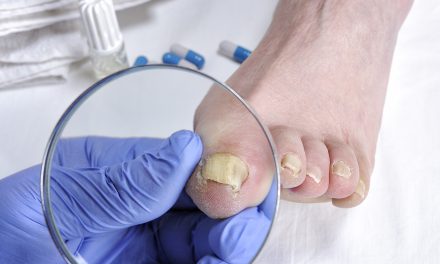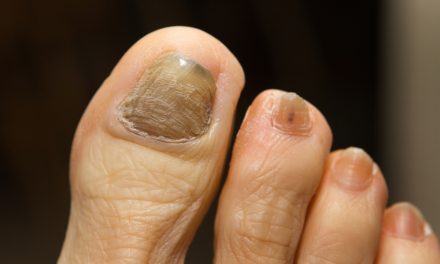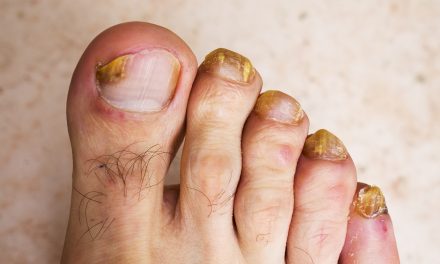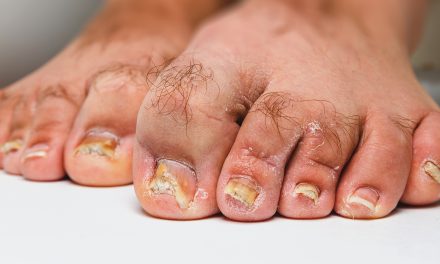Fungal infections can often be mistaken for minor skin conditions, but it’s important to be aware of their potential impact.
Toenail fungus, known medically as onychomycosis, is more than just an aesthetic issue. This fungal infection can spread to other parts of the body if not treated promptly.
It usually begins under the tip of a toenail and, without treatment, may become more serious.

Although toenail fungus spreads primarily through direct contact, it can also travel to other body areas, especially if there are cuts or breaks in the skin.
People with a weakened immune system or those with diabetes are at higher risk.
Regular hygiene practices and quick treatment of initial infections can play a crucial role in preventing the spread.
Key Takeaways
- Toenail fungus can spread to other body areas if untreated.
- Higher risk in people with weakened immune systems or diabetes.
- Early treatment and good hygiene prevent further complications.
Understanding Toenail Fungus

Toenail fungus, known as onychomycosis, is a common condition that can affect the appearance and health of nails. It involves dermatophytes and other fungi that invade the nail bed and can lead to significant changes in the nail’s structure.
What Is Toenail Fungus?
Toenail fungus is a type of fungal infection affecting the toenails. It usually starts as a small spot under the nail and can progress, causing the nail to thicken and discolor.
The infection is caused primarily by dermatophytes, which are fungi that thrive in warm, moist environments like the inside of shoes.
These fungi can affect anyone, but some factors increase the risk.
People who spend time in public swimming pools, gyms, or use communal showers are more susceptible. Those with sweaty feet or a history of athlete’s foot are also at greater risk.
Keeping feet clean and dry can help prevent the spread of this infection.
Causes of Onychomycosis
Onychomycosis is primarily caused by dermatophytes, but yeasts and non-dermatophyte molds can also be involved.
The fungi invade the nail bed through small cuts or separations in the nail, thriving in warm, damp conditions. Individuals with compromised immune systems are at increased risk.
Engaging in activities that lead to cracked or damaged nails also elevates the risk. Wearing tight or damp footwear is another contributing factor, as it creates a perfect environment for fungal growth.
Good hygiene, including regular washing and thorough drying of feet, is essential to prevent onychomycosis.
Symptoms and Diagnosis
Toenail fungal infections can be tricky to identify because their symptoms might seem minor at first. However, as the infection progresses, it can lead to more noticeable changes in the nails. Dermatologists can offer expert advice to correctly diagnose the infection and recommend appropriate treatment.
Identifying Toenail Fungal Infections
Toenail fungal infections often start with subtle changes.
Discoloration is a common early sign, with the nail turning white, yellow, or brown. The nail may become brittle or crumbly, making it prone to breaking.
Sometimes, a foul odor may develop, and the nail might thicken over time, causing discomfort when wearing shoes or walking.
In some cases, the infection can cause nail discoloration and the nail could become deformed. Pain is not always present in the early stages, but it can occur as the condition worsens.
If left untreated, the fungus may spread to other toenails or even infect the skin around the toe, leading to more complex issues.
When to See a Dermatologist
If symptoms like nail thickening or persistent discoloration appear, it’s wise to consult a dermatologist.
A dermatologist can evaluate the affected nails and provide an accurate diagnosis. Often, they will take nail clippings to send to a lab for testing, ensuring the right fungal type is identified.
Professional consultation is crucial for anyone with diabetes or a compromised immune system, as they are at higher risk of complications.
A dermatologist will tailor the treatment plan to the specific needs of the patient, ensuring a comprehensive approach to managing the infection. Seeking specialized care early can prevent the spread to other body parts and enhance nail health.
Risk Factors and Prevention
Toenail fungus can be influenced by certain environments and personal conditions. Understanding where the fungus thrives and taking steps to prevent infection can help reduce risks.
High-Risk Environments
Fungi that cause toenail infections thrive in warm and moist places. Public showers, swimming pools, and locker rooms are common high-risk areas. People who use these facilities might easily come into contact with fungi if they walk barefoot.
Those with athlete’s foot are also at risk since it can spread from the feet to the toenails and potentially other parts of the body.
Additionally, individuals with a compromised immune system are more susceptible to infections, as their bodies struggle to fight off pathogens effectively. Conditions like diabetes can also increase the likelihood of developing toenail fungus due to reduced blood circulation and nerve damage.
Preventative Measures
To prevent toenail fungus, one should avoid walking barefoot in public showers and locker rooms. Wearing flip-flops can provide a barrier against the fungi.
It’s crucial to keep feet clean and dry, especially after swimming or showering, as moisture promotes fungal growth.
Regularly inspecting feet for signs of infection, especially if one is diabetic or has a weakened immune system, is also important.
Maintaining good foot hygiene, such as trimming nails properly and changing socks regularly, also helps reduce the risk. Using antifungal powders or sprays in shoes can further protect against infection and help keep feet dry.
Potential Complications
Fungal nail infections can lead to serious issues if not treated, particularly for those with diabetes. Infections may spread beyond the nail, potentially causing further health concerns. Additionally, there’s a risk of secondary bacterial infections that can complicate the condition, requiring careful monitoring and treatment.
When Fungus Spreads Beyond the Nail
When the fungal infection extends beyond the toenail, it can affect the skin and deeper tissues. This spread may cause a condition known as cellulitis, which involves the inflammation of the skin and underlying tissues. People with diabetes are at higher risk due to issues like reduced blood circulation and neuropathy.
Once the fungus spreads, there may be pain, redness, and swelling. These symptoms are signs that medical attention is required.
Untreated, the infection could lead to more severe complications like ulcers or even systemic infections. It is crucial for individuals, especially diabetics, to check their feet regularly for any signs of spreading infection to avoid these complications.
Secondary Infections
Secondary bacterial infections can occur alongside a fungal infection in the toenail. Cuts or cracks in the skin, often caused by fungal infections, serve as entry points for bacteria.
This can lead to complications like an abscess or severe inflammation. Diabetics should be especially vigilant as they have a heightened risk.
Secondary infections might result in significant pain, increased redness, and pus formation.
Medications such as antibiotics are often required to treat the bacterial aspect. Regular foot hygiene and monitoring are recommended to prevent these secondary issues, and prompt consultation with a healthcare provider can make a significant difference.
Treatment Options
Effective treatment for toenail fungus involves different methods, including medications and alternative remedies. It’s important to address the infection properly to prevent it from spreading.
Medications to Fight Fungus
Toenail fungus can be managed with various antifungal medications.
Topical antifungals, such as creams and gels, are applied directly to the affected nail. These can help when the infection is mild and confined to small areas.
For severe infections, oral antifungal drugs are more effective since they reach deeper into the nail bed.
Terbinafine and itraconazole are two common oral antifungals that a healthcare provider might prescribe. These medications require several months of use and can have side effects.
In recent years, laser treatment has emerged as an option. It targets fungal cells without harming surrounding tissue.
Nail-softening creams help in removing infected parts of the nail. This can make treatments more effective.
Home Remedies and Alternative Treatments
Some people turn to home remedies and alternative treatments for toenail fungus.
One popular option is tea tree oil, known for its antifungal properties. Applying it to the affected nail might reduce fungal growth.
Vinegar and Vicks VapoRub are also common remedies. They might help, but there is limited scientific evidence supporting their effectiveness.
Other treatments include foot soaks using ingredients like baking soda. These can make the environment less favorable for fungal growth.
While alternative treatments may offer relief, they might not work for all cases. It’s advised to consult a healthcare provider for persistent infections or when using alternative methods alongside prescribed medications.
Lifestyle and Management
Managing toenail fungus effectively involves daily care and maintaining a healthy lifestyle. Implementing proper nail hygiene and making thoughtful lifestyle choices can reduce the risk of spreading the infection and ensure long-term nail health.
Daily Care for Healthy Nails
Maintaining clean and dry feet is crucial in preventing the spread of nail fungus. Fungal infections thrive in moist environments.
Ensure feet are thoroughly dried after washing, especially between the toes. Wearing breathable shoes and socks made from natural fibers like cotton can help keep moisture at bay.
Trimming nails straight across and filing down thickened areas can prevent the fungus from worsening.
Avoid sharing nail clippers or files to reduce the risk of spreading the infection. For those who use nail polish, consider using antifungal nail polishes that help combat infections and beautify nails simultaneously.
Long-Term Management of Nail Health
For lasting nail health, preventive measures must become part of a long-term routine.
Regularly inspecting nails for any signs of fungal infection allows for early detection and treatment, preventing the condition from worsening.
Activities like walking barefoot in public pools or showers should be avoided.
Eating a balanced diet rich in vitamins and minerals supports overall nail health.
Consulting healthcare professionals for topical treatments can aid in managing more persistent cases.
Fungal nail infections often require patience and consistent treatment over time, emphasizing the importance of adhering to recommended health practices.
Exploring Related Conditions
Toenail fungus can sometimes be mistaken for other conditions, or it might occur alongside different infections. Understanding similar skin conditions and the potential spread to other body infections is important.
Skin Conditions Mimicking Toenail Fungus
Several skin conditions can look like toenail fungus, making accurate diagnosis crucial.
Psoriasis is one such condition. It can cause nail changes like pitting, discoloration, and crumbling, similar to fungal infections.
Ringworm is another skin ailment often mistaken for nail fungus. Known medically as dermatophytosis, it is a skin infection caused by dermatophytes.
Jock itch is also caused by dermatophytes and affects the groin, but it may coexist with foot infections, misleading diagnosis efforts.
Accurate diagnosis through medical tests can help distinguish these conditions from toenail fungus, ensuring appropriate treatment.
Fungus’ Relationship with Other Body Infections
Toenail fungus, primarily caused by dermatophytes, can potentially spread, leading to conditions like tinea pedis, commonly referred to as athlete’s foot.
This condition often starts in the foot or between the toes and may advance to the toenails.
Individuals with skin infections or a weakened immune system may find the fungi spreading to other body areas.
The infection can also cause a dermatophytid (id) reaction, where skin eruptions appear in areas not directly infected, due to allergic reactions.
These linked infections highlight the importance of comprehensive treatment plans to prevent further spread and complications.
Frequently Asked Questions
Toenail fungus can spread and may pose health risks if untreated. Identifying healing signs and choosing effective treatments are crucial. Preventive measures can avoid contamination and transmission to others.
Is toenail fungus capable of spreading to the skin or internal organs?
Toenail fungus, also known as onychomycosis, can potentially spread to the skin, causing conditions like athlete’s foot. It is less likely to affect internal organs unless the individual’s immune system is significantly compromised.
Are there any serious health risks associated with untreated toenail fungus?
Untreated toenail fungus can lead to discomfort, nail damage, and secondary bacterial infections. For individuals with compromised immune systems or diabetes, there can be additional health complications due to possible skin infections.
How does a person ascertain if their toenail fungus is healing or dying off?
Signs that toenail fungus is healing include the growth of clear, healthy nail tissue and a reduction in discoloration and thickness.
Regular monitoring and consultation with a healthcare provider ensure proper tracking of progress.
What are the most effective medical treatments currently available for toenail fungus?
Medical treatments for toenail fungus include oral antifungal medications, topical treatments, and laser therapy. Each option has various degrees of effectiveness, depending on the individual’s condition and response to treatment.
What practices help prevent the transmission of toenail fungus to others?
Maintaining foot hygiene, wearing breathable footwear, and avoiding sharing personal items such as nail clippers or towels help prevent the spread of toenail fungus. Regularly cleaning and disinfecting shoes can also reduce transmission risks.
Under what circumstances can toenail fungus contaminate items like bedding or shoes?
Toenail fungus can contaminate items like bedding or shoes if they remain warm and moist.
Changing socks regularly, using antifungal powders, and ensuring proper ventilation can prevent these items from becoming sources of reinfection.

















